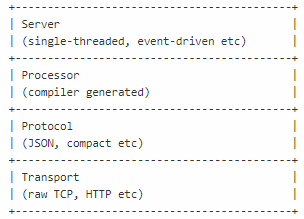
Transport
The Transport layer provides a simple abstraction for reading/writing from/to the network. This enables Thrift to decouple the underlying transport from the rest of the system (serialization/deserialization, for instance).
Here are some of the methods exposed by the Transport interface:
-
open
-
close
-
read
-
write
-
flush
In addition to the Transport interface above, Thrift also uses a ServerTransport interface used to accept or create primitive transport objects. As the name suggest, ServerTransport is used mainly on the server side to create new Transport objects for incoming connections.
-
open
-
listen
-
accept
-
close
Protocol
The Protocol abstraction defines a mechanism to map in-memory data structures to a wire-format. In other words, a protocol specifies how datatypes use the underlying Transport to encode/decode themselves. Thus the protocol implementation governs the encoding scheme and is responsible for (de)serialization. Some examples of protocols in this sense include JSON, XML, plain text, compact binary etc.
Here is the Protocol interface:
writeMessageBegin(name, type, seq)
writeMessageEnd()
writeStructBegin(name)
writeStructEnd()
writeFieldBegin(name, type, id)
writeFieldEnd()
writeFieldStop()
writeMapBegin(ktype, vtype, size)
writeMapEnd()
writeListBegin(etype, size)
writeListEnd()
writeSetBegin(etype, size)
writeSetEnd()
writeBool(bool)
writeByte(byte)
writeI16(i16)
writeI32(i32)
writeI64(i64)
writeDouble(double)
writeString(string)
name, type, seq = readMessageBegin()
readMessageEnd()
name = readStructBegin()
readStructEnd()
name, type, id = readFieldBegin()
readFieldEnd()
k, v, size = readMapBegin()
readMapEnd()
etype, size = readListBegin()
readListEnd()
etype, size = readSetBegin()
readSetEnd()
bool = readBool()
byte = readByte()
i16 = readI16()
i32 = readI32()
i64 = readI64()
double = readDouble()
string = readString()
Processor
A Processor encapsulates the ability to read data from input streams and write to output streams. The input and output streams are represented by Protocol objects. The Processor interface is extremely simple
interface TProcessor {
bool process(TProtocol in, TProtocol out) throws TException
}
Service-specific processor implementations are generated by the compiler. The Processor essentially reads data from the wire (using the input protocol), delegates processing to the handler (implemented by the user) and writes the response over the wire (using the output protocol).
Server
A Server pulls together all of the various features described above:
-
Create a transport
-
Create input/output protocols for the transport
-
Create a processor based on the input/output protocols
-
Wait for incoming connections and hand them off to the processor